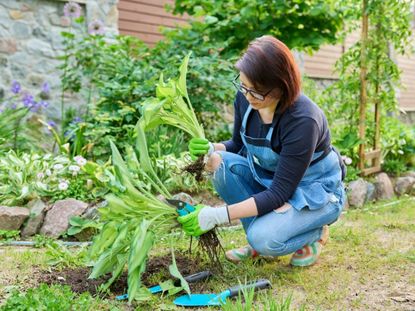How To Divide Perennials In Spring


Dividing perennials is a great way to expand your garden for free and spring is the best time to divide perennials that bloom in late summer or fall. Read on to learn about how to divide hostas, rudbeckias, and salvias this spring.
Tips For Transplanting Plants
How do you know when to divide perennials? When plants start dying out in the middle, it’s time to divide. However, it’s best to split plants before they start to suffer. Overcrowded plants have to compete for nutrients and water. They can also become diseased if they do not get enough airflow. You want to divide perennials before they start to look bad.
Water plants well the day before you divide them to make sure they are happy and hydrated. Prepare the hole where your transplants will go before you start digging. The less time plants spend out of the ground, the better.
Make sure to divide plants on an overcast or cloudy day. Never dig up and move plants when the sun is beating down on them. It will make their transition that much harder.
If plants are in bloom, wait to divide them. An easy rule of thumb is to divide fall-blooming plants in spring and spring-blooming plants in fall.
How To Divide Perennials
Hostas are easy to divide because they grow in clumps. New clumps grow off of the main plant and are ready for division after only a few years.
Grab a shovel and dig around the dripline of your hosta. That means dig straight down from the edge of the leaves. Keep as many roots intact as you can to give your hostas a smooth transition to their new home.
Gardening tips, videos, info and more delivered right to your inbox!
Sign up for the Gardening Know How newsletter today and receive a free download of our DIY eBook "Bring Your Garden Indoors: 13 DIY Projects For Fall And Winter".
If your plant is too big to move in one piece, split it up into smaller sections. Lay your hosta back in the hole and find a good place to divide your plant. One section is often made up of several smaller clumps.
Divide your hosta with a shovel, garden knife, or two pitchforks. Use the pitchforks to pry the plant apart, if the roots are not too dense. It may take a bit of effort for bigger plants, but hostas are quite hardy. Plus, if you divide them in early spring they will have plenty of time to bounce back and heal.
Separate the clumps and shake off any excess dirt. Now your new hosta plant is ready for planting under trees or in a shady spot in your garden. You can also plant part of your hosta back in the hole it came from or fill in the hole with dirt and let the rest of the hosta grow into the space.
Rudbeckia is a beautiful perennial that blooms in late summer. It sends out surface roots from the main plant to form new plants. You can dig up those clumps and transplant them elsewhere in your garden.
Follow the same process as the hostas. Dig around the dripline of the rudbeckia, but make sure to cut through the runner that connects the new clump from the main plant. If it is still visible above ground, you can cut it with a pair of clean garden shears.
Salvia is another easy-care perennial you can divide in spring. Once again, dig around the plant with your shovel. Shake loose any excess soil and pick out your dividing tool of choice. You can use a spade or your hands to untangle roots and avoid hurting the plant.
Plant divisions like you would any new plant from the nursery. Add good compost into the hole and mix it with the local soil. Make sure all the roots from your transplant are in the hole and plant it at the same height it was before division. Use your shovel handle to make sure the base of the plant is level with the ground around the hole. Then backfill with more soil and compost and water your transplants well.

Laura Walters is a Content Editor who joined Gardening Know How in 2021. With a BFA in Electronic Media from the University of Cincinnati, a certificate in Writing for Television from UCLA, and a background in documentary filmmaking and local news, Laura loves providing gardeners with all the know how they need to succeed, in an easy and entertaining format. Laura lives in Southwest Ohio, where she's been gardening for ten years, and she spends her summers on a lake in Northern Michigan. It’s hard to leave her perennial garden at home, but she has a rustic (aka overcrowded) vegetable patch on a piece of land up north. She never thought when she was growing vegetables in her college dorm room, that one day she would get paid to read and write about her favorite hobby.